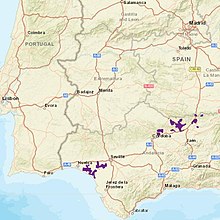| Iberian lynx | |
|---|---|

| |
| An Iberian lynx in Almuradiel, Spain | |
| Scientific classification | |
| Domain: | Eukaryota |
| Kingdom: | Animalia |
| Phylum: | Chordata |
| Class: | Mammalia |
| Order: | Carnivora |
| Suborder: | Feliformia |
| Family: | Felidae |
| Subfamily: | Felinae |
| Genus: | Lynx |
| Species: | L. pardinus
|
| Binomial name | |
| Lynx pardinus (Temminck, 1827)
| |

| |
| Distribution of Iberian lynx, 2015[needs update] | |
The Iberian lynx (Lynx pardinus) is one of the four extant species within Lynx, a genus of medium-sized wild cats. The Iberian lynx is endemic to the Iberian Peninsula in southwestern Europe. It is listed as vulnerable on the IUCN Red List.[3] In the 20th century, the Iberian lynx population had declined because of overhunting, poaching, fragmentation of suitable habitats, and the population decline of its main prey species, the European rabbit (Oryctolagus cuniculus), caused by myxomatosis and rabbit haemorrhagic disease.[4][5][6] Fossils suggest the species has been present in Iberia since the end of the Early Pleistocene, around one million years ago.
By the turn of the 21st century, the Iberian lynx was on the verge of extinction, as only 94 individuals survived in two isolated subpopulations in Andalusia in 2002. Conservation measures have been implemented since then, which included improving habitat, restocking of rabbits, translocating, reintroducing and monitoring Iberian lynxes. Between 2012 and 2024, the population had increased from a low of 326 individuals to some 2,021, leading to its reclassification as vulnerable.[7][8][9] It is a monotypic species, and is thought to have evolved from Lynx issiodorensis.
- ^ Boscaini, A.; Alba, D.M.; Beltrán, J.F.; Moya-Sola, S. & Madurell-Malapeira, J. (2016). "Latest Early Pleistocene remains of Lynx pardinus (Carnivora, Felidae) from the Iberian Peninsula: taxonomy and evolutionary implications". Quaternary Science Reviews. 143: 96–106. Bibcode:2016QSRv..143...96B. doi:10.1016/j.quascirev.2016.05.015. hdl:11336/182970.
- ^ a b Rodríguez, A. (2024). "Lynx pardinus". IUCN Red List of Threatened Species. 2024: e.T12520A218695618. Retrieved 30 June 2024.
- ^ Cite error: The named reference
reboundwas invoked but never defined (see the help page). - ^ Simón, M.A. (2012). Ten years conserving the Iberian lynx. Seville: Consejería de Agricultura, Pesca y Medio Ambiente. Junta de Andalusía. ISBN 978-84-92807-80-2. Archived from the original on 21 June 2024. Retrieved 3 January 2017.
- ^ Rodríguez-Hidalgo, A.; Lloveras, L.; Moreno-García, M.; Saladié, P.; Canals, A. & Nadal, J. (2013). "Feeding behaviour and taphonomic characterization of non-ingested rabbit remains produced by the Iberian lynx (Lynx pardinus)". Journal of Archaeological Science. 40 (7): 3031–3045. Bibcode:2013JArSc..40.3031R. doi:10.1016/j.jas.2013.03.006. hdl:10261/153608. Archived from the original on 21 June 2024. Retrieved 29 January 2019.
- ^ Fordham, D.A.; Akçakaya, H.R.; Brook, B.W.; Rodríguez, A.; Alves, P.C.; Civantos, E.; Trivino, M.; Watts, M.J. & Araujo, M.B. (2013). "Adapted conservation measures are required to save the Iberian lynx in a changing climate" (PDF). Nature Climate Change. 3 (10): 899–903. Bibcode:2013NatCC...3..899F. doi:10.1038/nclimate1954. hdl:10261/84387. Archived (PDF) from the original on 3 January 2017. Retrieved 2 January 2017.
- ^ Lopez, G.; Lopez, M.; Fernandez, L.; Ruiz, G.; Arenas, R.; Del Rey, T.; Gil, J.M.; Garrote, G.; Garcia, M. & Simon, M. (2012). "Population development of the Iberian lynx since 2002". Cat News. 57: 34.
- ^ Jones, S. (2020). "The lynx effect: Iberian cat claws its way back from brink of extinction". The Guardian. Archived from the original on 25 October 2020. Retrieved 29 October 2020.
- ^ Cite error: The named reference
guardian-vulnerablewas invoked but never defined (see the help page).
